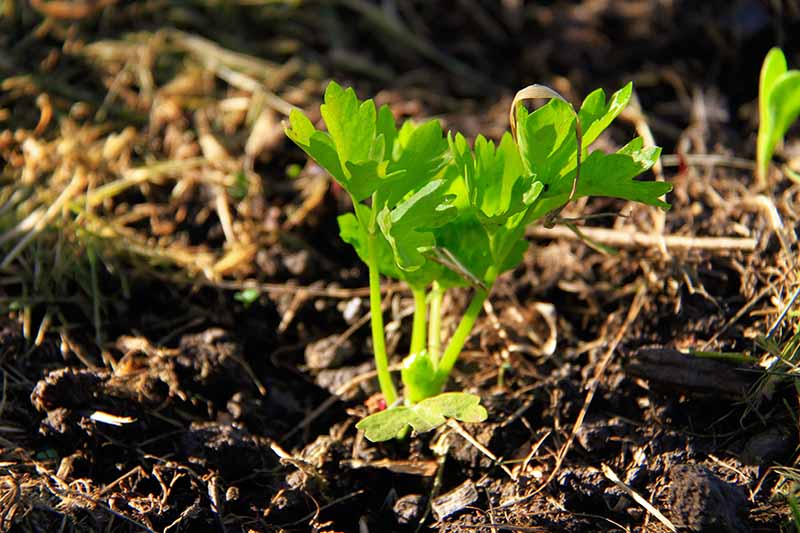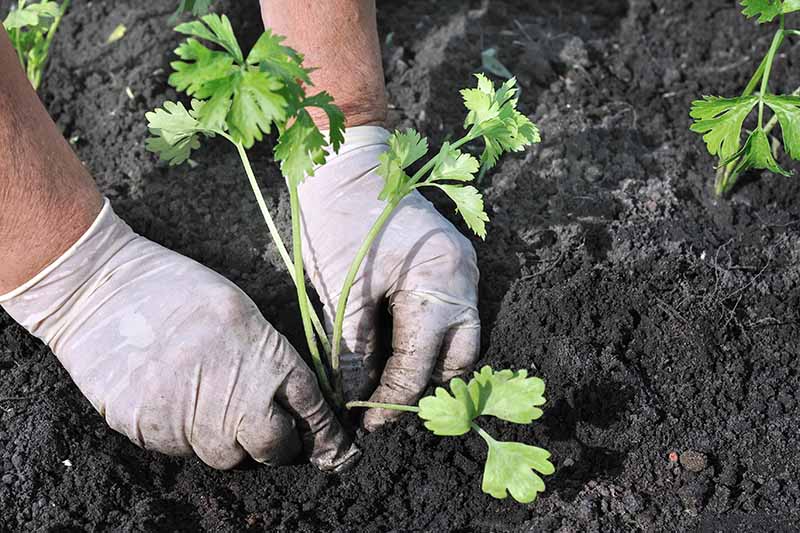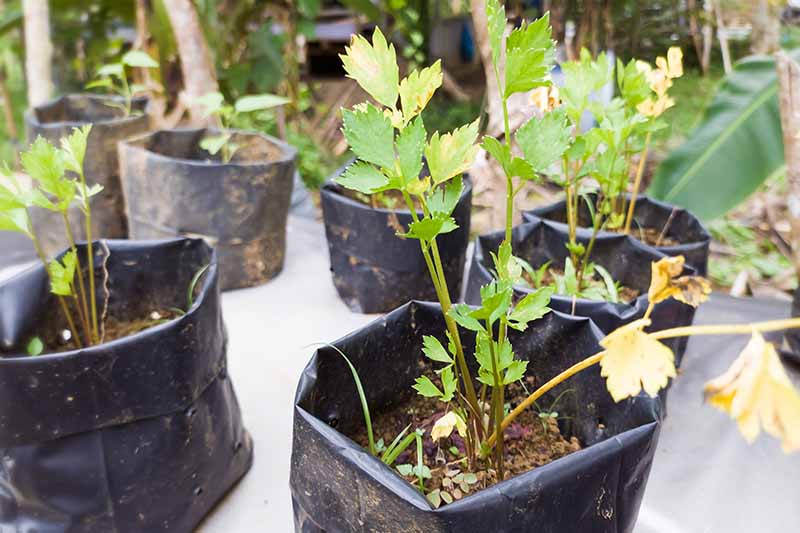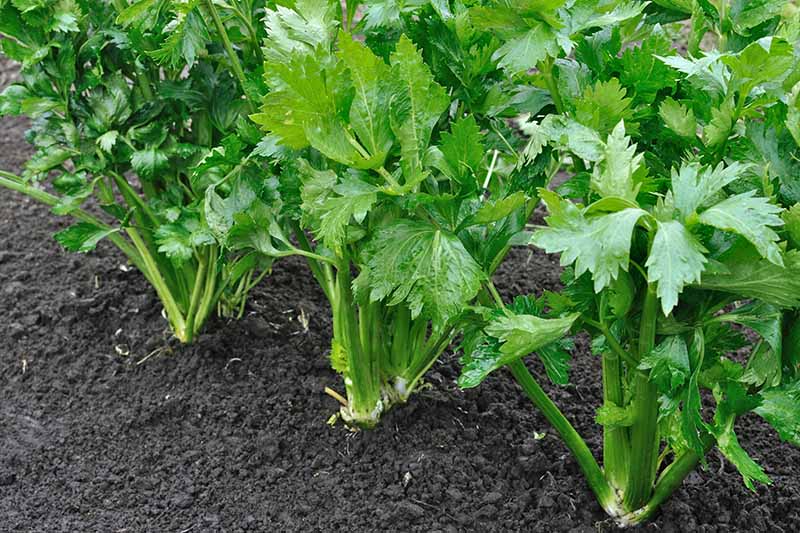Who wouldn’t want a lustrous and shapely eggplant, or a voluptuous juicy pear? But lots of luck to the blemished tomato, the yam with the wireworm tunnels, and thin types, like me. Hey, celery, I can relate. Sometimes, you just don’t plump up the way people expect you to. And while celery, Apium graveolens, is not one of nature’s curvaceous vegetable specimens, its statuesque ribs are quite the standout on a crudite tray when they are firm and crisp. We link to vendors to help you find relevant products. If you buy from one of our links, we may earn a commission. In this article, we focus on seven reasons why celery ribs may not flesh out the way they ought to, and how to avoid this common issue. Here’s what we’ll cover: Let’s take a look at each.
1. Inadequate Light
From the start, these plants need lots of light. The tiny seeds are sown on top of loose soil, where light and moisture trigger germination. They need a sunny window or grow light when started indoors in late winter, and full sun – six hours per day – upon transplant to the garden after the danger of frost has passed. Starting early in a cool zone is perfect for an early summer harvest. If you live in a warm zone, you can direct sow seeds in late summer for an early winter harvest, and may find that your crop fares best with light afternoon shade. Without the light it craves, celery may fail to perform optimally.
2. Lack of Nutrients
A “heavy feeder,” A. graveolens requires organically-rich soil teeming with nutrients. Compost and aged manure are excellent soil amendments that boost the nutrient content of the soil, as you may have discovered in our growing guide. The addition of a 5-10-10 (NPK) fertilizer is an essential supplement, as this is a shallow-rooted vegetable that feeds high in the ground, and it needs all the food its short roots can take up.
3. Moisture Stress
As you may also have discovered in our growing guide, celery grows naturally in swampy regions. And although today’s cultivars don’t like to sit in puddles, they do require even moisture throughout their maturation. In the absence of rain, providing one and a half inches of supplemental water per week is crucial. Without it, ribs that should be full of moisture begin to shrink. Affected foliage is likely to turn yellow, which can be confusing. Over-watered plants can also turn yellow. However, with too much water, the ribs swell rather than shrinking, often to the point of cracking. It’s best not to set the irrigation system and forget it. Listen closely to the weather forecast, as a farmer does, and take care to supplement or withhold water as needed.
4. Pests or Disease
A lack of water may cause vulnerability to pest damage. Foliage sap-suckers, like the aphid, and soilborne parasites, like the root-knot nematode, may feed to such an extent that foliar and root growth may be stunted. Pests can also be “vectors,” or carriers of diseases that further weaken flora. Although moisture stress is the most likely culprit for thinness, pests and disease may contribute to the emaciation of stalks. If you notice signs of pests on foliage, try using a firm spray with a hose nozzle to dislodge them. If that doesn’t work, treat the foliage with organic insecticidal neem oil. To manage parasitic nematodes, apply food-grade diatomaceous earth at planting time as a preventative, or at the first signs of root damage. You may want to consult with a representative from your local agricultural extension first, as beneficial nematodes may be destroyed in the process.
5. Premature Harvest
Celery takes a long time to mature. Old varieties may not be harvest-ready for 140 days. There are newer cultivars that are ready to eat in as few as 85 days, like ‘Tango Hybrid,’ as described in our article on celery varieties. If you get antsy and pick your crop too soon, the ribs – and hence entire stalks – may be quite narrow in diameter. Why would you harvest too early? Perhaps you sowed seeds too late in a growing zone with hot summers and freezing winters. As vegetables start to show signs of heat and moisture stress, you may find you have no choice but to cut them early, or risk a total loss. Or maybe you thought you had a modern cultivar that matures in 85 days, when you really have an old heirloom variety growing that needs a full 140 days. Remember to read your seed packets to understand your selected variety and allow ample time for maturity, or your plants may not achieve full stature.
6. Temperatures Are Too Hot
As mentioned, celery is a cool-weather crop that is best started indoors in late winter in zones that freeze, for an early summer harvest. If you start seeds too late, plants may suffer not only from moisture stress, but from the drying effects of the heat itself. Similarly, if you live in one of the warmest zones, don’t sow seeds too early in the summer, or they, too, may succumb to heat they can’t tolerate, long before early-winter harvest time. In addition to the desiccated (dry), thin ribs and yellowing typical of moisture stress, plants may bolt, or suddenly flower and set seed. If they do this, they stop growing altogether, and never get any bigger. This is especially likely in the event of a heatwave that comes on rapidly. Avoid this reason for skinny stalks altogether by sowing seeds appropriately for your growing zone, so plants are not maturing during periods of hot weather.
7. Varietal Characteristics
Sometimes a plant disappoints us, and we realize it’s not the type we thought we had sown. We may have purchased seeds without taking the time to read the packets thoroughly, or we may occasionally end up with a package that has been improperly labeled. There are numerous cultivated varieties available. Chinese celery, Apium graveolens var. secalinum, aka cutting or leaf celery, has characteristically narrower ribs than regular A. graveolens. As both often top out at 12 inches, confusing the two is an easy mistake to make. If you are growing the Chinese type, you may inadvertently let it grow beyond its peak, hoping for a large-diameter stalk with substantial ribs, instead of the loose cluster of narrow ones it typically produces. Let’s recap and wind things up. You may find that the ribs and entire stalks may be on the thin side if any of the following conditions are affecting them: The planting location lacks adequate light. There is a deficiency in nutrients essential for healthy development. Plants are not getting enough water. Pests like sapsuckers and root knot nematodes are causing stunting, and pests may serve as vectors of disease. Seeds are sown too late in cool climates, and too early in warm ones, and it’s too hot for them to mature normally. You have a plant, like the Chinese species, that is naturally on the thin side. With these seven reasons in mind, it’s time to increase your support of the celery in your veggie patch, so it can achieve proportions worthy of a Renaissance work of art. Have you experienced thin stalks on your celery plants? Let us know in the comments section below! If you enjoyed this celery-growing troubleshooting guide, check out these articles for more information next:
5 Reasons Why Your Celery Tastes Bitter (And What to Do About It)How to Blanch Celery in the Garden (And Why You Should!)When and How to Harvest Celery






